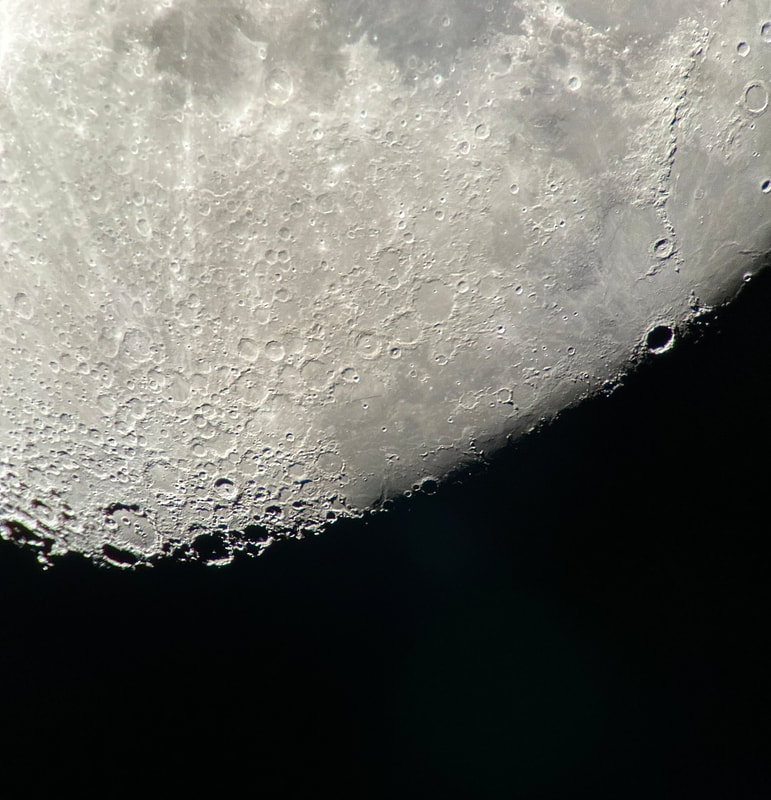|
Usually, the atmosphere is turbulent during our DC winters, but this winter has been an exception. The reason might have to do with atmospheric circulation rerouted by a particularly intense El Niño, but I'm not sure. In any case, winter has been unusually accommodating for amateur astronomy in the District. Yet I haven't taken out my telescopes, and I haven't updated this blog, because, unfortunately, I've found myself too sick, too overworked, or - most often - both. This month has been much better, however, and on the 18th I finally decided to give my kids a view of the halfway-illuminated Moon. I stepped out with what is now my smallest refractor - the Takahashi FC-100DZ - and quickly found atmospheric turbulence to be a little worse than average. That's perfectly okay for a DC winter, and after the telescope cooled down - in about ten minutes - it delivered a very nice view of the Moon. Unfortunately, when uploaded to this blog the picture looks a bit blurrier than it does on my desktop. But look closely at the center. That's Rupes Recta, a linear fault about two kilometers wide that cuts across some 110 kilometers of the lunar surface. Here it is zoomed in: Just below the fault are the craters Birt A and B, named after William Radcliff Birt, a nineteenth-century selenographer. Birt coordinated a network of amateur lunar observers across Britain who all sought to record changes in lunar features, which they thought would reveal the Moon to be a world similar to Earth. It's a story that I'll describe in my next book, Ripples on the Cosmic Ocean. The book is one reason I've been so busy this winter: I've finished a complete draft, and am now revising (partly by shortening). In any case, the kids enjoyed the Moon. For them, it's a neat little thing that daddy likes to show off occasionally. Of course, I try to impress them by waxing poetic about the wonder of gazing, from a comfortable little backyard, at the alien peaks and hollows of a whole other world, one utterly different from our own. They're appreciative, but hardly awestruck. I've decided that it's nice that Moongazing is so normal for them. The following night was clear again, but a good deal colder. Still, I decided to try my Mewlon 210. After letting it acclimate for about 90 minutes, I walked over to a nearby tennis court and pointed it at the Moon. Once again, I was struck by just how easy the Mewlon is to handle. It's lightweight, and you hold it by the rock-solid finder scope. It's just a wonderfully-crafted hunk of metal and glass. It's hard not to want to use it, if that makes sense. When I pointed the Mewlon at the Moon - and yes it's so nice not to have to attach and then align the finder scope - I found it was cooled down and well-collimated. Atmospheric seeing was about average, but the view was quite breathtaking. The terminator had advanced a little beyond my favorite spot on the Moon - the expanse between and around Plato and Copernicus - yet both craters retained a hint of shadow around their rims. The Mewlon gave a three-dimensional quality to the extraordinary complexity of the terrain in this part of the Moon, in particular the mountains and crater rims. The iPhone pictures I took suggest some off-center coma distortion, but I noticed nothing while viewing the Moon. I don't know what to make of that. Still, I can report that I stepped inside - hands nearly frozen - thinking that I'd be crazy to ever sell my Mewlon. On the following night - that's the 20th - I sat down to write this blog entry. Then I noticed the Moon, shining through my window. I checked and, lo and behold, seeing was supposed to be better than average - way better than I normally expect in winter. I hesitated, but of course the temptation was too strong. I stepped out with the DZ, because I needed something that cooled down fast. This time the view was truly sublime. With the Moon near zenith and the atmosphere unusually stable, the fully-acclimated DZ showed off what it can do. The view wasn't as bright as the Mewlon offered on the previous night, but owing to the steady atmosphere they were a bit more detailed. I noticed craterlets on Plato's floor with the Mewlon - a classic test of good seeing and optics - but now, with the DZ, they were more continuously obvious.
I soaked in the view for a 30, maybe 45 minutes as my fingers slowly froze. I did notice that the view routinely slipped ever so slightly out of focus, owing perhaps to the focuser with the telescope pointed straight up. But wow, that in-focus view was wonderful: among the best I've had of the Moon. I especially enjoyed the lunar maria. The picture above gives a hint of the delicate tendrils I followed across those maria: subtly different shadings, some radiating from brilliant, intricately-detailed craters. It was a lot to take in, but my fingers soon convinced me to pack up and head inside. Lunar observing is perhaps overlooked in amateur astronomy, but it truly is an incomparable experience to explore another world while standing within sight of home.
2 Comments
|
Archives
March 2024
Categories
All
|










 RSS Feed
RSS Feed